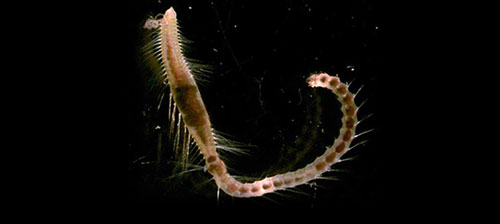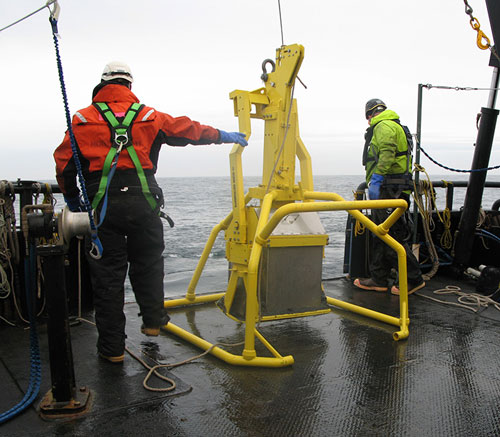
By Sarah Hardy, Co-Expedition Principal Investigators, University of Alaska Fairbanks

Bristle worm collected from seafloor mud with a box core during a 2002 Arctic ocean exploration mission. Image courtesy of Bodil Bluhm and Casey Debenham, University of Alaska Fairbanks (UAF). Download larger version (jpg, 36 KB).
The muddy seafloor comprises the largest habitat on Earth, ranging from shallow continental shelf to the abyssal seafloor thousands of meters deep. Seafloor sediments support an enormous diversity of life. Some fishes and larger invertebrates, such as sea cucumbers and urchins, can be found living on, or just above, the sediment surface.
However, the vast majority of organisms live within seafloor sediments themselves. Much of this life—particularly in deeper waters—is microscopic in size and not visible to the naked eye. Sediment communities consist of a wide array of microscopic organisms, ranging from marine worms and crustaceans to single-celled protozoa and bacteria. This microscopic life carries out crucial ecosystem functions that impact not only marine food chains, but the global cycling of carbon between oceans and atmosphere.

Box corers are used to collect sediment samples from the seafloor. Image courtesy of Sarah Hardy. Download larger version (jpg, 197 KB).
Most of the muddy seafloor receives little to no sunlight, and thus does not support plant life that would form the base of the food chain in other shallow-water or terrestrial ecosystems. Instead, seafloor organisms rely largely on the sinking of decaying organic material from the lighted surface waters or, in Arctic sediments, from algae living within the sea ice.
Thus, many of the organisms on the muddy seafloor are deposit feeders, which use ciliated feeding palps, tentacles, or other structures to pick up and ingest organic particles from the sediment surface or shovel bulk sediment into their mouths as they move, digesting the useful organic material and expelling the mineral component as feces.
Decaying organic material is not a particularly nutritious food source, compared to live algae or animal tissue that might feed organisms at the surface or in shallower water. For example, some of this sinking organic material consists of fecal matter—indigestible material from food that has already passed through the guts of organisms at the surface. Deposit-feeders have specialized guts designed to maximize the amount of nutritional value they can extract from this poor food source. The diversity of life in sediments is all the more surprising given the lack of food.
Bacteria play a crucial role in processing hard-to-digest organic material in sediments to make nutrients more readily available to other organisms, and also serve as food themselves. Some bacteria free living in sediments, but deposit feeders also host a consortium of specialized bacteria within their guts (i.e., a “microbiome”), just as other animals do. The movement of animals living and feeding within the sediments helps to bring oxygen into the sediments, stimulating bacterial activity and supporting aerobic respiration by animal life. Marine sediments thus operate as a massive bio-reactor, where chemical processing of organic matter is mediated by resident bacteria and animals.
Sediments also constitute one of the largest and longest-term storage reservoirs of carbon on Earth, such that this chemical processing can impact the exchange of carbon (most importantly, carbon dioxide) between the oceans and atmosphere.
Production of organic matter in the Arctic is highly seasonal, due to the short period of time during spring and early summer when conditions are conducive to the growth of algae. Seafloor communities thus receive short-term pulses of food during the bloom period.
The annual advance and retreat of sea ice has a further structuring role on the seasonal production of algae, both in the surface waters and within the ice itself. For example, sea-ice algae appear to be a particularly rich food source for marine animals because it contains high levels of polyunsaturated fatty-acids (PUFAs, e.g., the essential omega-3 fatty acids).
If sea-ice loss continues in the Arctic, the loss of ice-algal input to the pool of sinking organic material may have major nutritional consequences for consumers. However, PUFA-producing bacteria have also been detected in deposit-feeder guts and may provide an alternative source of these nutrients.